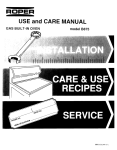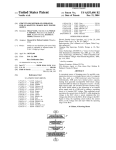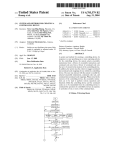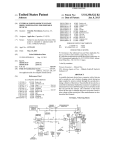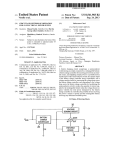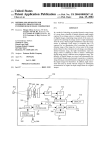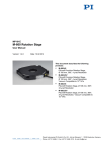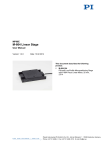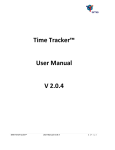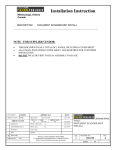Download \I \ Power
Transcript
US008188717B2 (12) United States Patent (10) Patent N0.: (45) Date of Patent: Schubert (54) ACTIVE COMMUNICATIONS BUS POWER US 8,188,717 B2 May 29, 2012 FOREIGN PATENT DOCUMENTS HARVESTER FOR DIFFERENTIAL SIGNAL COMMUNICATION SYSTEM W0 W0 2008-011894 A1 1/2008 OTHER PUBLICATIONS (75) Inventor: Clifford Schubert, Sidney (CA) KK Systems, Ltd., K2 RS232-RS422/485 Converter, K2-ADE RS232-RS485 Converter With ADE, 2002 KK Systems, Ltd., Ed. 2, (73) Assignee: Schneider Electric USA, Inc., Palatine, IL (US) (*) Notice: Jan. 11, 2002 (6 pages). Allen-Bradley, User Manual Smart Self-Powered Serial Converter (Cat. No. 1203-SSS) Series B FRN2.xxx, Rockwell Automation, Publication 1203-5.15iAug. 1999 PN 193416(01) (44 pages). International Search Report for International Application No. PCT/ US2010/059099, dated Jul. 20, 2011 (4 pages). Written Opinion of The International Searching Authority for Inter national Application No. PCT/US2010/059099, dated Jul. 20, 2011 Subject to any disclaimer, the term of this patent is extended or adjusted under 35 U.S.C. 154(b) by 340 days. (21) Appl. No.: 12/648,937 (6 pages). (22) Filed: Dec. 29, 2009 * cited by examiner (65) Prior Publication Data US 2011/0156658A1 Primary Examiner * Ramy Ramadan Jun. 30, 2011 (74) Attorney, Agent, or Firm * Nixon Peabody LLP (51) Int. Cl. H02] 7/00 (52) US. Cl. ..................................................... .. 320/137 (58) Field of Classi?cation Search ................ .. 320/162, (2006.01) (57) A balanced differential signal communication system having at least tWo data lines connecting multiple nodes in series, each node comprising a signal generator for applying signals 320/ 137 See application ?le for complete search history. (56) ABSTRACT to the data lines that produce a controllable differential volt age across the data lines; a rechargeable storage device for References Cited receiving electrical energy from the data lines to charge the storage device; at least one device coupled to the storage device for receiving electrical energy_ from the storage device; _ U.S. PATENT DOCUMENTS 6,363,066 B1 3/2002 Frimodig 7,034,503 B2 * 4/2006 Veselic et a1‘ ,,,,,,,,,,,,, n 320/128 and a controllable converter couplrng the data lrnes to the 7,391,299 B2 7,576,635 B2 6/2008 Bender et al. 8/2009 Bender et 31 storage device for controlling the charging and discharging of the storage device With poWer captured from the data lines. 7,612,654 B2 2007/0168596 A1 11/2009 Bender et al. 7/2007 Hall et al. 2009/0322271 A1 * 12/2009 Zimmermann ............. .. 318/440 16 Claims, 4 Drawing Sheets [- 1 0 12 R3 11 R1 S+ \ R2i \ \I \ _ Power Harvester Device Device Device A B N 11b ( US. Patent May 29, 2012 Sheet 1 of4 US 8,188,717 B2 [-10 12 R3 11 R1 8+ R4 \ \ R2 ( Power Harvester S_ _ Device Device Device _ A B N 11a 11b FIG. 1 110 US. Patent May 29, 2012 US 8,188,717 B2 Sheet 3 0f 4 101 ls storage power enough to start 102\ microcontroller? f 104 DC-DC uses reference voltage to determine loading and operate as single unit load. Captures energy from bias voltage/messages until enough power to Start microcontroller. If at any time power goes below threshold, power down micro and restart. start up microcontroller Micro now controls variable load. 103 105 Are there previously stored 106 \ network setting? r107 Load harvesting settings and . . Turn on bus driver and voltage resume operation. . . . . sense, listen for messages from Start up radio. Continue to adjust . . . different present device bus harvesting parameters as . . drivers from other devices needed. 108 essages 1 O9 \ 3 1 10 Heard? N f Analyze messages to Try sending message and listen for determine network type and other devices on bus. Record signal response. Determine if any other devices and their characteristics strength. (protocol, signal strength, etc) f1 1 1 Analysis provides: statistics on devices with most > powerful transmit power, longest message <— response, max load harvester can apply. + /1 12 Adjust loading to provide maximum power + /-1 13 Save network settings + I f- 1 1 4 Query periodically to keep power reserves up. Start up radio. Continue to adjust harvesting parameters as needed. FIG. 3 US. Patent May 29, 2012 Sheet 4 of4 US 8,188,717 B2 201 Stable power supply available? K 202 Power up & configure radio Wait for data from radio 204 Is the message for the Harvester bus or the arvester? f 205 207 \ Send data out bus, Analyze message (time sync, wait for reply polling schedule, etc) i K206 20s\Apply changes, send l acknowledge — Send data out through radio if required. Start radio . scheduled polling, etc. FIG. 4 — US 8,188,717 B2 1 2 ACTIVE COMMUNICATIONS BUS POWER HARVESTER FOR DIFFERENTIAL SIGNAL COMMUNICATION SYSTEM inputs receiving the control signal produced by the microcon troller; and a source of a ?xed reference voltage coupled to the FIELD OF THE INVENTION may be programmed to send messages via the data lines to other nodes coupled to the data lines to cause the other nodes to respond to the messages via the data lines, and the converter other of the inputs to the multiplexer. The microcontroller The present invention relates generally to supplying poWer captures poWer from the responses for recharging the storage device. to devices coupled to a differential signal communication system by harvesting electrical poWer from data lines of the communication system. One embodiment includes a sensor coupled to the data lines for sensing the voltage differential betWeen the data lines and supplying a signal representing the voltage differ BACKGROUND ential to the microcontroller, and a microcontroller is pro Differential signal communication systems are in Wide spreaduse. For example, RS-485 is a Well knoWn serial digital communication system that uses balanced differential signals for communicating With computers and other devices. RS-485 alloWs multiple devices to communicate at half-du tial to determine a load that can be imposed on the data lines grammed to use the signal representing the voltage differen plex on a single pair of Wires, plus a ground Wire, over long distances. Both the length of the netWork and the number of nodes can easily be extended using a variety of different repeater products that are readily available. The properties of Without interfering With communications on the data lines. The converter is preferably controllable to vary the load that the converter imposes on the data lines, so that the load does not interface With communicating via the data lines. 20 The invention may best be understood by reference to the differential signals provide high noise immunity and long distance capabilities. RS-485 is the most versatile communication standard in folloWing description taken in conjunction With the accom panying draWings, in Which: 25 the standard series de?ned by the EIA, as it performs Well for FIG. 1 is a block diagram of an RS-485 communication system that includes multiple nodes and a poWer harvesting device for harvesting electrical poWer from the data lines of the bus. connecting data terminal equipment (DTE) directly Without the need of modems, for connecting several DTE’s in a net Work structure, for communicating over long distances, and for communicating at fast communication rates. RS-485 is currently a Widely used communication interface in data BRIEF DESCRIPTION OF THE DRAWINGS 30 FIG. 2 is a block diagram of one of the nodes in the system of FIG. 1. FIG. 3 is a How chart of a program executed by the micro acquisition and control applications Where multiple nodes controller in the node of FIG. 2 to control the harvesting of communicate With each other. RS-485 signals are ?oating electrical poWer from the bus. FIG. 4 is a How chart of a program executed by the micro controller in the node of FIG. 2 to control radio/bus messag 1ng. With each signal being transmitted over a S+ line and a S line. The RS-485 receiver compares the voltage difference betWeen the tWo lines, rather than the absolute voltage level 35 on a single line. RS-485 interfaces are often preferred for data acquisition and control applications because RS-485 is capable of inter netWorking multiple transmitters and receivers in the same network. High-resistance RS-485 inputs alloW a large num DETAILED DESCRIPTION 40 Although the invention Will be described in connection With certain preferred embodiments, it Will be understood that the invention is not limited to those particular embodiments. On the contrary, the invention is intended to cover all alter ber of nodes to be used, and RS-485 repeaters can be used to increase the number of nodes even more. natives, modi?cations, and equivalent arrangements as may BRIEF SUMMARY 45 be included Within the spirit and scope of the invention as de?ned by the appended claims. The present disclosure provides a balanced differential signal communication system having at least tWo data lines gram of an RS-485 communication system that includes a connecting multiple nodes in series, each node comprising a signal generator for applying signals to the data lines that 50 and multiple nodes formed by devices 11a, 11b . . . 11n Turning to the draWings, FIG. 1 is a functional block dia differential bus 10 is formed by a pair of data lines S+ and S—, produce a controllable differential voltage across the data coupled to the bus 1 0 at different points along the length of the lines; a rechargeable storage device for receiving electrical energy from the data lines to charge the storage device; at bus. An RS-485 communication channel can be shared by least one device coupled to the storage device for receiving electrical energy from the storage device; and a controllable converter coupling the data lines to the storage device for multiple receivers and multiple senders. In the illustrative embodiment, the bus 10 is terminated by resistances R1 and 55 controlling the charging of the storage device With poWer captured from the data lines. One implementation includes a microcontroller coupled to the controllable converter and producing a control signal that affects the amount of poWer captured from the data lines by the converter; a multiplexer coupled betWeen the microcon troller and the converter and having a pair of input terminals for receiving a pair of input signals, an output terminal, and a control input for receiving a control signal from the micro controller for selecting Which input signals are included in the output signal produced at the output terminal, one of the R2 at opposite ends, and a bias voltage is supplied to one end of the bus from a source 12 through voltage divider formed by a pair of resistors R3 and R4 in combination With the termi nating resistor R1. For high bit rates and long Wiring runs, termination resistances are necessary on both ends of the bus 60 10 to eliminate re?ections, but not at drop points along the bus. Highbit rates are possible because the transitionbetWeen logical 0 and logical l is only a feW hundred millivolts, and currently available RS-485 drivers can achieve bit rates of at least 35 mbps. 65 Although FIG. 1 illustrates an RS-485 tWo-Wire multi-drop bus, it Will be understood that an RS-485 netWork can also be connected in a four-Wire mode, using four data Wires and an US 8,188,717 B2 3 4 additional signal ground Wire. In a four-Wire network, one is a rechargeable battery, it may be installed pre-charged to reduce the initial charge and discovery time, or it may be node is a master node and all others are slave nodes. The network is connected so that the master node communicates initially charged by some other means such as a USB plug-in to all slave nodes, and all slave nodes communicate only With to a computer. the master node. Since the slave nodes never listen to another slave response to the master, a slave node cannot reply incor rectly to another slave node. RS-422 systems are also use To control the charging of the energy storage device 34, the microcontroller produces control signals for a multiplexer 35 that also receives a reference voltage form a reference voltage source 36. The multiplexer 35 selects one of its tWo inputs, from the microcontroller 22 and the reference voltage source 36, for application to the converter 33. The selection is con trolled by a “select” signal generated on output line 2211 from the microcontroller 22 and applied to the select input of the multiplexer 35, Which determines Which of the tWo multi balanced differential signals, using a dedicated pair of Wires for each signal, a transmit pair, a receive pair and an additional pair for each handshake/ control signal used (if required). In a “tWo-Wire” netWork the transmitter and receiver of each device are connected to a tWisted pair. “Four-Wire” netWorks have one master port With the transmitter connected to each of the “slave” receivers on one tWisted pair. The “slave” trans plexer inputs is supplied to the converter 33. It Will be under stood that either a digital or analog multiplexer may be used, depending on the type of control desired for the converter 33. mitters are all connected to the “master” receiver on a second tWisted pair. In either con?guration, devices are addressable, alloWing independent communications With each node. FIG. 2 is a more detailed illustration of one of the node devices 11, Which includes a communication and bus loading control 20 and an energy capture system 30, both of Which are coupled to the tWo data lines 8+ and S- of the bus 10. As is Well knoWn, the data lines 8+ and S- are preferably in the form of a tWisted pair, to provide noise immunity. The energy capture system 12 supplies electrical poWer to a poWer supply 40 that poWers the communication and bus loading control 20 other devices on the bus. By controlling the converter, the system is able to vary the load it puts on the bus 10 to capture more or less poWer, While ensuring that the load does not interfere With communications. The converter may be con 25 11. Within the communication and bus loading control 20, an RS-485 bus driver 21 sends signals to, and receives signals from, the data lines 8+ and S- of the bus 10. The driver 21 delivers received signals to a microcontroller 22, and receives signals from the microcontroller 22 for delivery to the bus 10. Only one device can drive the data lines at a time, so the drivers at the various nodes must be put into a high-imped 30 35 storage device 34 capture a small amount of poWer from the biasing circuit for the bus 10. The converter 33 varies its load to draW as much poWer as possible from the bus biasing standard. Any communications that occur on the bus 10 alloW the converter 33 to charge the storage device 34 faster than just the biasing voltage, and those communications can also be used to identify the type of netWork or protocol being used, as described in more detail beloW. 40 After the storage device 34 has accumulated enough energy to enable the microcontroller 22 and the driver 21 to generate a request, they transmit a harmless request to the other nodes on the bus 10, such as a Modbus read or identify ance tri-state Within a feW microseconds after data has been sent, so it is not necessary to have delays betWeen data packets on the RS-485 bus. These tristate capabilities of RS-485 nodes alloW a single pair of Wires to share transmit and trolled to change not only the poWer captured from the bus 1 0, but also the impedance it presents to the bus to improve communication and/ or the poWer harvesting capabilities. Upon connection to the bus 10, the converter 33 and the circuit Without exceeding the speci?cation of the communi cations system or dropping the biasing voltage beloW the appropriate threshold for the applicable communications ance mode (tri-state) When they are not in use. An RS-485 driver is typically enabled and disabled by an RTS control signal from an asynchronous serial port. Setting the RTS line to a high (logic 1) state enables the driver, While setting the RTS line to a loW (logic 0) state puts the driver into a tristate condition that in effect disconnects the driver from the bus, alloWing other nodes to transmit over the same pair of data lines. The RS-485 driver typically returns to its high imped This control of the converter 33 enables the system 30 to capture small amounts of energy from the biasing voltage on the bus 10, or to capture larger amounts of energy from data signals on the bus When the data lines 8+ and S- are driven by 45 receive signals for half-duplex communications. request. The microcontroller may identify the desired type of communication automatically by monitoring traf?c on the bus 10, or the microcontroller may have been pre-con?gured The microcontroller 22 also receives the output of an for a certain setting. If there is no response to a request operational ampli?er 23 that has tWo inputs coupled to the generated by the microcontroller 22 and the driver 21, the converter 33 continues charging the storage device 34 from tWo data lines 8+ and 8-, so that the output of the ampli?er 23 represents the difference betWeen the voltage levels on the tWo data lines 8+ and S—. The microcontroller 22 also 50 receives inputs from a real time clock 24 and a radio trans the bias voltage While the microcontroller 22 continues to generate different types of messages or targets different nodes until a response is received. ceiver 25, and delivers control signals to the energy capture After a response is received, the poWer-harvesting system system 30, as Will be discussed in more detail beloW. The transceiver 25 is typically a generic loW poWer radio trans ceiver, such as a ZigBee radio, or the transceiver may be has a better source of poWer and can begin issuing additional requests to detect other protocols or devices on the netWork. For example, certain nodes on the bus 10 may have stronger replaced With a signal/protocol converter. The energy capture system 30 includes a recti?er 31 having a pair of inputs coupled to the tWo data lines 8+ and S—, producing a recti?ed output that is smoothed by a ?lter 32 and 55 drivers, Which can be detected by varying the load on the netWork While listening for a response, or certain nodes may 60 then supplied as the DC input to a controllable DC-to-DC converter 33. The DC output of the converter 33 is supplied to an energy storage device 34, such as a rechargeable battery or an ultra capacitor. The output of the storage device 34 is connected to the poWer supply 40 that supplies poWer to the respond faster or support other commands that produce longer responses and therefore supply more poWer for each request. The microcontroller may be programmed to look for the option that Will provide the most poWer for charging the storage device 34, both in terms of the device’s driving capa communication and bus loading control 20, including the bilities and the ratio of poWer received to poWer required to transmit. In the illustrative example With the radio 25, the microcon microcontroller 22 and the radio 25. When the storage device troller 22 can turn on the radio 25 and thus begin Wireless 65 US 8,188,717 B2 5 6 communications after a stable source of energy has been response, the maximum load the harvester can apply to the obtained and su?icient energy has been stored. Other nodes on the bus 10 can be polled as needed to maintain the required poWer. When the illustrative device is acting as a bridge or con verter betWeen a radio netWork and a Wired communications bus 10 Without adversely affecting communications, etc. From step 11, the system advances to step 112 to adjust the loading on the bus 10 to provide maximum poWer to recharge the storage device 34, and then those netWork settings are saved at step 113. Then step 114 queries the netWork settings bus, incoming requests can be buffered While poWer is being periodically and adjusts the poWer-harvesting parameters as harvested from the Wired bus. Then a message can be trans needed to maintain a maximum poWer reserve. It Will be mitted from the Wireless network, and any response Will be understood that the loading on the bus is adjusted by the DC-to-DC converter 33 in response to the output signal received by the converter from the multiplexer 35, Which in turn is controlled by the control signal applied to the select input of the multiplexer 35 by the microcontroller 22. forWarded back onto the radio netWork. The radio 25 or the entire device may be designed to go into a loW poWer “sleep” state and only poWer up When traf?c is received from the Wired communications bus, or in response to a periodic radio timer. FIG. 4 is a How chart of a routine executed by the micro controller 22 to control messaging operations via the radio 25 and the bus 10. The radio 25, Which can Wait to be triggered by FIG. 3 is a How chart of a poWer-up sequence for the poWer harvester illustrated in FIG. 2. Step 101 determines Whether the energy storage device 34 has accumulated enough poWer to start the microcontroller 22, and if the ansWer is negative, step 102 indicates that the DC-to-DC converter 33 uses the ?xed reference voltage from source 36 to determine the load ing on the bus 10. That is, the converter 33 operates as a single another device or can query a central device on poWer up, 20 The routine in FIG. 4 begins at step 201, Which determines unit load, capturing energy from the bias voltage and any messages on the data lines S+ and S- until enough poWer is accumulated in the storage device 34 to start up the micro controller 22. When the response at step 101 is af?rmative, the micro controller 22 is started at step 104 so that the balance of the steps in FIG. 3 can be executed by the microcontroller. If at any time the poWer available from the storage device 34 drops beloW a preselected threshold, the microcontroller 22 is poW ered doWn and re-started When the accumulated poWer again Whether a stable poWer supply is available, based on stored data relating to poWer supplied to the microcontroller from 25 30 35 synchronization, polling schedule, etc. Step 208 then applies required, starts scheduling polling, etc. While particular embodiments and applications of the 40 the netWork settings periodically and adjusts the poWer-har 45 When step 105 yields a negative response, indicating that there are no previously stored netWork settings, the system advances to step 107 to turn on the bus driver 21, to turn on the voltage differential-sensing ampli?er 23, and to listen for messages. The system then advances to step 108 to listen for messages. When a message is detected, step 108 produces an af?rmative response, Which advances the system to step 109 Which analyZes the message to collect data from the message, such as netWork type, other devices on the bus and signal strength. The collected data is then analyZed at step 111 to determine desired statistics such as the identity of devices 50 spirit and scope of the invention as de?ned in the appended claims. The invention claimed is: 1. A balanced differential signal communication system having at least tWo data lines connecting multiple nodes in series, each node comprising a signal generator for applying signals to said data lines that produce a controllable differen tial voltage across said data lines, a receiver coupled to said 55 data lines for detecting said differential voltage, a recharge able storage device coupled to said data lines for receiving electrical energy from said data lines to charge said storage device, at least one device coupled to said storage device for receiving electrical energy from said storage device, and a controllable converter coupling said data lines to said storage device for controlling the charging of said storage device With having the most transmit poWer, the longest message response, the maximum load the harvester can apply to the bus 10 Without adversely affecting communications, etc. When no message is detected, step 108 yields a negative present invention have been illustrated and described, it is to be understood that the invention is not limited to the precise construction and compositions disclosed herein and that vari ous modi?cations, changes, and variations may be apparent from the foregoing descriptions Without departing from the vesting parameters as needed to maintain a maximum poWer reserve. determines Whether the radio message is for the bus 10 or the poWer harvester. If the message is for the bus, the data is sent out on the bus 10 at step 205, after being reformatted by the microcontroller 22 if necessary, and is then sent out on the radio 25 at step 206. If step 204 determines that the radio message is for the poWer harvester, the routine advances to step 207 to analyZe the message for information such as time any changes, sends an acknowledgment through the radio if determines Whether there are any previously stored netWork settings. If step 105 yields an af?rmative ansWer, the system proceeds to step 106 to load any settings for the poWer har vester settings and resume operation, including turning on the radio 25. The system then advances to step 114, Which queries the poWer supply 40 over a selected time interval. This step repeats until it produces an af?rmative response, Which advances the system to step 202 to poWer up and con?gure the radio 25. Step 203 then Waits for data from the radio 25, and advances to step 204 When such data is received. Step 204 rises above that threshold. After the microcontroller 22 has been started, the microcontroller 22 controls the variable load imposed on the bus 10 by the DC-to-DC converter 33, via the control signal applied to the select input of the multiplexer 35 by the microcontroller. From step 104, the system advances to step 105, Which serves to synchroniZe multiple poWer harvesters and to relay messages betWeen the bus 10 and another location, either on request or as part of a scheduled operation. 60 response, the system advances to step 110 to transmit a mes poWer captured from said data lines, Wherein said signal generator generates signals for transmission to other nodes coupled to said data lines to stimulate said other nodes to sage via the bus driver 21 and then listen for a response. Any response is used to collect the same type of data collected at 111 to determine desired statistics such as the identity of generate signals for transmission via said data lines, to pro vide additional poWer to be captured by said converter from said data lines. 2. The balanced differential signal communication system devices having the most transmit poWer, the longest message node of claim 1 Which includes a microcontroller coupled to step 109, namely, netWork type, other devices on the bus signal strength, etc. The collected data is then analyZed at step 65 US 8,188,717 B2 8 7 12. The balanced differential signal communication sys said controllable converter and producing a control signal that affects the amount of poWer captured from said data lines by tem node of claim 2 Which includes said converter. 3. The balanced differential signal communication system a multiplexer coupled betWeen said microcontroller and said converter and having a pair of input terminals for of claim 1 in Which said controllable converter imposes a DC-to-DC load on said data lines at a default level, and Which receiving a pair of input signals, an output terminal, and includes control circuitry for overriding said default-level microcontroller for selecting Which input signals are included in the output signal produced at said output terminal, one of said inputs receiving said control signal a control input for receiving a control signal from said load to increase the DC-to-DC load on said data lines to increase the rate of charging said storage device. 4. The balanced differential signal communication system node of claim 1 Which includes a bias voltage source coupled produced by said microcontroller, and a source of a ?xed reference voltage coupled to the other of to said data lines for applying a bias voltage across said data lines. said inputs to said multiplexer. 13. A method of harvesting electrical poWer from a bal 5. The balanced differential signal communication system anced differential signal communication system having at node of claim 1 Which includes a voltage source and bias least tWo data lines connecting multiple nodes that include a resistors connected across said data lines to maintain a mini mum bias current How in said data lines for noise suppression. signal generator for applying signals to said data lines to 6. The balanced differential signal communication system node of claim 1 in Which said controllable differential voltage produce a controllable differential voltage across said data lines, and a receiver coupled to said data lines for detecting has tWo different levels, representing the tWo states of a binary signal transmitted via said communication line. said differential voltage, said method comprising coupling a 20 7. The balanced differential signal communication system node of claim 1 in Which said rechargeable storage device is rechargeable storage device to said data lines through a con trollable converter that charges said storage device With elec trical energy captured from said data lines, coupling at least a rechargeable battery or a capacitor. one device to said storage device for receiving electrical 8. The balanced differential signal communication system node of claim 2 in Which said microcontroller is programmed energy from said storage device, and generating signals for 25 transmission to other nodes coupled to said data lines to 30 stimulate said other nodes to generate signals for transmis sion via said data lines, to provide additional poWer to be captured by said converter from said data lines. 14. The method of claim 13 Which includes rectifying non-DC energy removed from said data lines, said control to send messages via said data lines to other nodes coupled to said data lines to cause said other nodes to respond to said messages via said data lines, said converter capturing poWer from said responses for recharging said storage device. 9. The balanced differential signal communication system node of claim 1 in Which said converter is controllable to vary the load that said converter imposes on said data lines, so that said load does not interface With communicating via said data lines. 10. The balanced differential signal communication sys lable converter imposes a DC-to-DC load on said data lines, and controlling said DC-to-DC load to adjust the rate of charging said storage device Without interfering With com munications on said data lines. 35 tem node of claim 2 Which includes a sensor coupled to said data lines for sensing the voltage differential betWeen said data lines and supplying a signal representing said voltage charging said storage device. differential to said microcontroller, and said microcontroller is programmed to use said signal representing said voltage 40 differential to determine a load that can be imposed on said data lines Without interfering With communications on said data lines. 11. The balanced differential signal communication sys tem node of claim 1 in Which said load imposed by said controllable converter on said data lines is an adjustable resis tive or reactive load. 15. The method of claim 14 in Which said DC-to-DC load is imposed on said data lines at a default level, and Which includes overriding said default-level load to increase the DC-to-DC load on said data lines to increase the rate of 16. The method of claim 13 Which includes sending mes sages via said data lines to other nodes coupled to said data lines to cause said other nodes to respond to said messages via said data lines, said converter capturing poWer from said responses for recharging said storage device. 45









